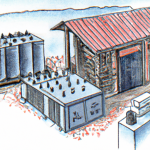
Building a Fishing Pond on Your Homestead
Living on a homestead provides many opportunities for self-reliance and sustainability. One of those opportunities is to build a fishing pond on your property. Not only can a fishing pond provide a valuable source of food, but it can also serve as a recreational space for you and your family. In times of crisis, having a reliable food source becomes even more crucial. Here is a guide on how to build a fishing pond on your homestead, so you can be prepared for whatever may come.
1. Assess Your Property
The first step in building a fishing pond is to assess your property and determine the location of the pond. Look for a spot that is relatively flat and has good drainage. Ideally, the area should receive at least six to eight hours of sunlight per day. Take note of any nearby trees that may shade the pond, as excessive shade can inhibit the growth of fish.
2. Obtain Permits
Before digging, it is important to check with your local authorities to determine if you need any permits or approvals to build a fishing pond. Each area may have different regulations and requirements, so make sure to do your due diligence before starting any construction.
3. Dig the Pond
Once you have obtained any necessary permits, it’s time to start digging. The size of your pond will depend on the available space and your desired capacity. However, a pond that is at least a quarter acre in size will provide a sufficient habitat for fish to thrive. Use heavy machinery or hire a professional if necessary, as digging a pond can be a labor-intensive task.
4. Line the Pond
After the pond has been excavated, it’s time to line it with a waterproof material to prevent leakage. You can choose from several options, including clay, bentonite, or synthetic liners. Consult with a pond construction specialist to determine the best lining material for your specific needs.
5. Fill the Pond
Once the pond has been lined, it’s time to fill it with water. You can use rainwater, natural springs, or a combination of both sources. If neither is available, consider using well water. Avoid using tap water, as it may contain chemicals that can harm the fish.
6. Stock the Pond
Now that your pond is filled, it’s time to introduce fish into their new home. Research the types of fish that are suitable for your climate and the size of your pond. Common fish species for fishing ponds include bass, trout, catfish, and sunfish. Make sure to obtain the fish from a reputable source to ensure their health and survival.
7. Maintain the Pond
Once your fishing pond is established, it requires regular maintenance to ensure its longevity. Monitor the water quality regularly and make any necessary adjustments. Keep the pond free from debris, such as fallen leaves or branches, to prevent water contamination. Consider installing aeration systems or natural filtration methods to promote the health of the fish.
Conclusion
Building a fishing pond on your homestead is an excellent way to provide both food and recreation for you and your family. In times of crisis, having a reliable source of food becomes even more vital. By following these steps and taking the necessary precautions, you can create a fishing pond that will serve you well for many years to come. Start your journey towards self-reliance today.



GIPHY App Key not set. Please check settings